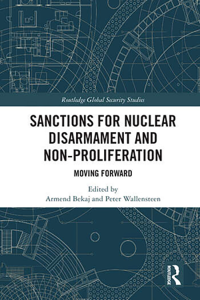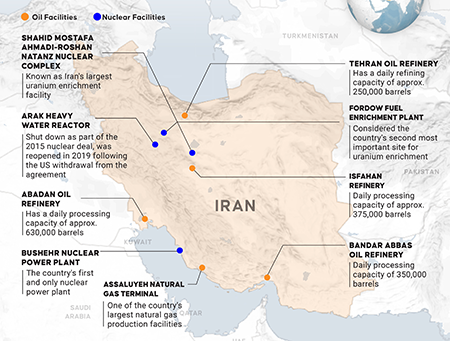Sanctions for Nuclear Disarmament and Non-Proliferation: Moving Forward
April 2025
Reviewed by Kelsey Davenport

Sanctions for Nuclear Disarmament and Non-Proliferation: Moving Forward
By Armend Bekaj and Peter Wallensteen, eds.
Routledge Global Security Studies
2025
Making Sanctions More Effective
In the last several decades, sanctions have played a central role in international efforts to prevent the spread of nuclear weapons. Despite the increasing reliance on such unilateral and multilateral measures, their utility as a tool of statecraft in pressing nations to abandon nuclear weapons programs is largely unquestioned in policymaking circles. With a looming proliferation crisis on the horizon, fueled by territorial aggression and diminishing trust in alliances, sanctions will probably remain a key fixture in responding to the threat of new nuclear-armed states. But how effective are sanctions as a tool for preventing proliferation and promoting disarmament? How are they best integrated into broader strategies to prevent the spread of nuclear weapons?
Sanctions for Nuclear Disarmament and Non-Proliferation provides a critical and timely contribution to understanding the role of sanctions in disarmament and nonproliferation policy and to challenging established narratives about the utility of coercive measures in preventing the spread of nuclear weapons. The contributors deconstruct sanctions as a tool of statecraft and propose a working theoretical framework for employing and lifting sanctions. They also seek to discern how sanctions, and more specifically, certain types of sanctions, impact the target state’s decision to proliferate or disarm using case studies.
In deconstructing sanctions and providing a more nuanced approach to applying them, the book provides a much-needed evidence-based critique of the generalizations that frequently drive sanctions policy. The critique is more compelling in that it does not dismiss sanctions outright as a tool; it acknowledges the role that these coercive measures can play if properly calibrated and integrated into a broader strategy. The book does not consider sanctions in a vacuum but rather examines the necessity of rethinking the diplomatic frameworks and approaches in which sanctions operate, further contributing to the overarching policy relevance. Although this book is relevant to academics and policymakers, its arguments and conclusions are especially applicable for using sanctions more effectively for addressing contemporary proliferation challenges.
Positive and Negative Sanctions
One key contribution to policymaking is the discussion of the role that positive sanctions or inducements should play in nonproliferation and disarmament strategies. In contrast to negative sanctions, which are intended to punish or penalize, positive sanctions are additive, providing a benefit to the targeted state. Policymakers frequently dismiss positive sanctions as a sign of weakness or a reward for the targeted state, particularly if that state has not taken steps to reverse the activities that prompted sanctions.

David Cortright and Thomas Biersteker directly challenge that narrative in the chapter “Incentivizing Nonproliferation” and argue compellingly that positive sanctions pay dividends by creating opportunities for engagement and willingness to cooperate. Overreliance on negative sanctions, in contrast, isolates a state and can close off opportunities for interaction. The authors discredit the notion that negative sanctions alone will push the targeted state to change course. They suggest an integrative approach, which combines coercive sanctions targeted at decision-makers representing the offending state with focused engagement and incentives.
Cortright and Biersteker pay equal attention to the policy implications of relief from negative sanctions. In addition to providing a flexible framework for releasing pressure from negative sanctions in response to concessions from the targeted state, Cortright and Biersteker contend that inducements, such as investment guarantees, can supplement sanctions relief. The 2015 nuclear deal between Iran and six world powers highlights the importance of this point, where lifting sanctions alone did not provide the tangible economic benefits that Iran expected under the deal.
Although positive sanctions are rarely used today, the case study of West Germany by Dogukan Cansin Karakus illustrates the role that they can play. The author contends that the “multifaceted approach combining punitive actions with incentive-driven strategies” used by the United States influenced West Germany’s decision to join the nuclear Nonproliferation Treaty (NPT) in 1969. He further identifies that distinct characteristics shape a state’s decision-making and argues for a tailored strategy that considers a state’s ideology, security concerns, and economic imperatives in crafting an approach that balances positive and negative sanctions.
One theme that resonates through several chapters is the disconnect between perceptions of sanctions’ effectiveness and the impact of these measures on a targeted state’s behavior. George Lopez, for instance, calls attention to the outdated or erroneous generalizations about sanctions policy that still inform decision-makers, including the concept that noncompliance with sanctions should drive further sanctions imposition and that partial compliance by the targeted state suggests that holding firm on implementing sanctions will lead to
full compliance.
Lopez presents a more accurate list of data-driven maxims for guiding sanctions policy, including the assessment that excessively punitive sanctions on broad sectors such as banking and trade are rarely successful and more often lead to the targeted state doubling down on its position rather than shifting its behavior. He argues that when a state employs sanctions without a strategy for engaging the targeted state it creates an environment in which sanctions become the strategy rather than a tool. He also posits that if sanctions are going to change a state’s behavior, it is most likely to happen in the first two and a half years of imposition.
Another policy-relevant contribution focuses on the importance of aligning sanctions action with a specific objective and clearly articulating that objective to the targeted state. The chapter on efforts to prevent proliferation in China and India by Rishika Chauhun offers a particularly useful breakdown for thinking about the relationship between sanctions and policy goals. Her approach to aligning sanctions to one of four key objectives offers a useful heuristic to policymakers who will pursue and assess sanctions effectiveness.
Chauhun’s framework states that sanctions can be used to demonstrate a response, deter future action, constrain a state from continuing a behavior, and coerce a state to improve its behavior. This approach of articulating specific nonproliferation objectives for sanctions is particularly relevant for U.S. policy. Increasingly, the United States has relied on overly broad sanctions measures and attempted to tie relief from those sanctions to the targeting state changing its behavior in multiple areas. Crafting targeted sanctions with more specific objectives could help policymakers better assess their effectiveness and better communicate their goals to the international community. It also would signal to the targeted state the concessions necessary to achieve sanctions relief.
Nuclear-weapon State Division
That observation is particularly relevant today, when unity among the five nuclear-weapon states recognized and bound by the NPT on prioritizing nonproliferation efforts is fracturing. As Lopez notes, shifts in the global economic system and the demise of the UN Security Council as “the major law-based structure with the authority and global support for imposing sanctions” negatively impact consistent sanctions use for nonproliferation policy. In recent years, for example, China and Russia have shielded North Korea from additional Security Council sanctions, despite blatant North Korean violations of UN restrictions on its nuclear program. Furthermore, the Trump administration’s decision to withdraw the United States from the 2015 nuclear deal with Iran in 2018, despite Tehran’s compliance, eroded the credibility of sanctions lifting. Policymakers will need to grapple with the implications of great- power disunity diminishing sanctions effectiveness as the world responds to proliferation threats.

The shifting proliferation environment and the emergence of nuclear weapons discourse in states that are U.S. allies or partners suggests that Washington will need to grapple with contradictions between pursuing national security and prioritizing nonproliferation. In a chapter focused on Pakistan, Bekaj and Chihaun review how U.S. security interests in Pakistan clashed at times with sanctions targeted at Pakistan’s nuclear weapons program. The authors describe the U.S. approach to stymieing Pakistan’s nuclear weapons ambitions as “erratic and dysfunctional” and the implementation of sanctions relegated to a less important role compared with the country’s geostrategic value. Pakistan’s relationship with China, and Beijing’s willingness to assist at certain periods, led the authors to conclude that the threat of sanctions and the ability of the international community to lift sanctions were credible only when there was international consensus.
The lessons drawn from the Pakistan case are particularly relevant when considering the U.S. response to possible future proliferators. Apart from Iran, current proliferation threats include Saudi Arabia, South Korea, and Turkey. In these cases, geostrategic interests could be competing with nonproliferation norms, possibly impacting the extent to which the sanctioning state would enforce negative sanctions targeting nonproliferation. This dynamic underscores the necessity of rethinking positive sanctions and of integrating inducements into nonproliferation strategies.
In addition to its utility in challenging predominant narratives that portray sanctions as a panacea, the book raises important questions for further research that could positively influence how sanctions are used in statecraft. While arguing that positive sanctions should be a more integrated part of nonproliferation policy, the authors acknowledge that more research on such inducements and the sequencing of positive and negative sanctions is necessary. They point out that security guarantees and alliances historically have served as important inducements, but the shifting geopolitical landscape has diminished the credibility of security commitments. Without addressing the security drivers of proliferation, states will be less likely to reverse nuclear weapons programs. The United States, in particular, will need to examine the consequences for proliferation that could emerge from rolling back extended deterrence commitments and questioning the value of alliances.
Another area that could be ripe for further study is the potential role of nuclear cooperation—in areas such as energy generation, medicine, and agriculture—as a positive sanction. In addition to providing direct benefits to the state, positive sanctions in the peaceful nuclear cooperative space would build additional transparency around nuclear programs and foster ties between expert communities that could be used to clarify intentions.
As well as highlighting the gaps between the perceived and actual effectiveness of sanctions, the book provides new, compelling guidelines for the use of sanctions in a more integrative strategy. Dispelling deeply held beliefs by policymakers, particularly in the United States, however, will be challenging.
With multiple proliferation threats looming, nonproliferation policy will remain a critical issue for years to come. This book is an indispensable contribution to rethinking how sanctions are applied and framed to prevent the spread of nuclear weapons.
